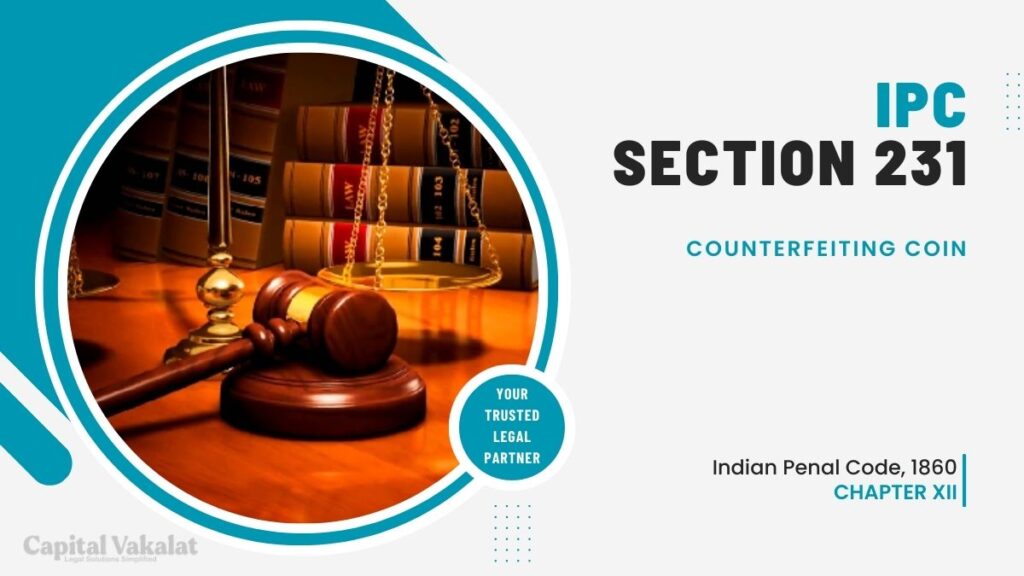Section 231 of the Indian Penal Code (IPC) deals with a significant offense that has the potential to disrupt financial stability and trust in the economic system – counterfeiting coins. Counterfeiting coin, a form of financial fraud, is not only illegal but also detrimental to a nation’s economy.

This article delves into the various aspects of Section 231 IPC, aiming to provide a comprehensive understanding of this offense and its consequences.
Understanding Counterfeiting Coin
Counterfeiting coin involves creating fraudulent replicas of genuine currency coins with the intention to deceive and defraud others. The counterfeit coins are designed to closely resemble real ones, making it difficult for ordinary citizens and even experts to differentiate between the real and counterfeit currency. Counterfeit coins are typically made of inexpensive materials but are often treated to appear genuine.
The Legal Framework: Section 231 IPC
Section 231 IPC specifically addresses the act of counterfeiting coinage. It declares that whoever counterfeits coin and intends to pass it off as genuine, or possesses counterfeit coin with the knowledge that it is counterfeit, shall be subject to punishment. This section underlines the gravity of the offense and the importance of preserving the integrity of the financial system.
Punishment for Counterfeiting Coin
The punishment for counterfeiting coin is rigorous, in line with the serious consequences it can have on the economy. Offenders can face imprisonment for a term extending to ten years, along with a fine. The severity of the punishment reflects the government’s commitment to preventing and deterring this crime.
Historical Significance of Coin Counterfeiting
Coin counterfeiting is not a new phenomenon. Throughout history, counterfeiters have tried to undermine the financial systems of various civilizations. In ancient times, counterfeit coins were made from base metals and used to defraud merchants and traders. Understanding the history of this crime helps us appreciate its enduring significance and the need for stringent laws like Section 231 IPC.
Detecting Counterfeit Coins
Detecting counterfeit coins can be a challenging task, given the sophisticated techniques employed by counterfeiters. This section will delve into the various methods used by experts to differentiate between genuine and counterfeit coins. It will also shed light on the importance of public awareness in combating this crime.
Preventing Coin Counterfeiting
Prevention is often the most effective way to combat counterfeiting. This part of the article will discuss the security measures put in place by governments to safeguard their currency. Elements like holograms, microprinting, and specific metals make counterfeiting coins a complex endeavor. This section also highlights the role of technology in preventing coin counterfeiting.
Impact of Counterfeiting on the Economy
The economic repercussions of coin counterfeiting are profound. This section will explore how the circulation of counterfeit coins can lead to inflation, a decrease in public trust, and economic instability. The article will underline the need for stringent laws and vigilant law enforcement to protect the financial system.
Notable Cases of Coin Counterfeiting
This section will provide examples of notorious cases of coin counterfeiting from around the world. These case studies will illustrate the extent to which individuals and criminal organizations are willing to go in their pursuit of counterfeit coin production. Understanding these cases can shed light on the ongoing challenges in combating this crime.
Conclusion: Combating Coin Counterfeiting
In conclusion, Section 231 IPC plays a crucial role in safeguarding the financial stability and trust within the Indian economic system. The offense of counterfeiting coin is not to be taken lightly, as it can have dire consequences for a nation’s economy. Stringent punishment, awareness, and advanced security measures are all essential in preventing and combating this crime effectively.
Frequently Asked Questions
How do experts differentiate between genuine and counterfeit coins?
Experts use various techniques such as microprinting, the study of minting details, and advanced machinery to detect counterfeit coins. Public awareness and education are also critical in detecting counterfeit coins.
Can modern technology help prevent coin counterfeiting?
Yes, modern technology plays a crucial role in preventing coin counterfeiting. Governments incorporate features like holograms and unique metals into their coin design, making it increasingly difficult for counterfeiters to replicate them.
What are the economic consequences of widespread coin counterfeiting?
The circulation of counterfeit coins can lead to inflation, erode public trust in the currency, and disrupt the economic stability of a nation. It can also result in financial losses for individuals and businesses.
Are there any recent advancements in the fight against coin counterfeiting?
Advancements in technology have led to more sophisticated security features on coins, making it harder for counterfeiters to produce convincing fakes. Law enforcement agencies are also collaborating to combat coin counterfeiting at a global level.